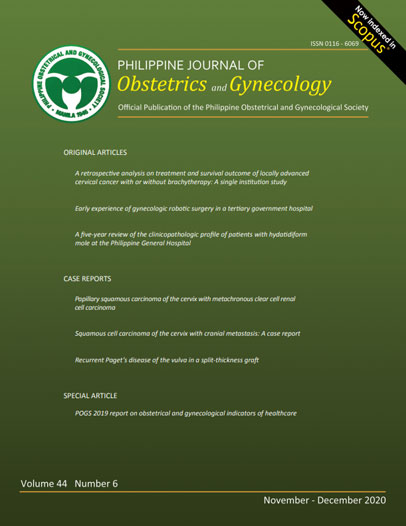Search for articles
Article Detail
Sonographic features and clinical correlates of correctly positioned and malpositioned intrauterine device in women examined at a tertiary hospital: A five year review
Regina Rosario M. Panlilio-Vitriolo, MD, FPOGS, FPSUOG and Nur Ainee D. Kamensa, MD, FPOGS
Department of Obstetrics and Gynecology, Philippine General Hospital, University of the Philippines-Manila
Objective: To describe the sonographic features of correctly positioned and malpositioned intrauterine device (IUD) in women and correlate with associated symptoms and concurrent cervical, uterine and ovarian pathology
Methodology: This is a 5-year retrospective cross-sectional study. Patients in a tertiary hospital with sonographically detected correctly positioned and malpositioned IUDs were selected from the Obstetrics and Gynecology Ultrasound Database from January 1, 2014 to December 31, 2018. The patient’s name and case number were used to review the patient’s charts for the demographic profile and other necessary data. Intrauterine device sonographic features were recorded, correlated clinically and analyzed statistically.
Results: Three hundred two patients were eligible for the study with ages between 41 to 50 years old and with an average of 1 to 3 pregnancies and livebirths. Almost half of the women with malpositioned IUDs complained of missing IUD string. Sonographically, the IUD appeared echogenic with more than half demonstrating a linear echogenic stripe. The most common type of malpositioned IUD was partial or fully embedding the myometrium (45.2 %), followed by those located in the cervix or in the lower uterine segment (35.7%), partially expelled with IUD segment extending through the external cervical os (11.9%), and fragmented (4.7%). The least common malpositioning was malrotation of the IUD (2.3%). There were significantly more women with cervical disease among those who had correctly placed IUDs. Thirteen women were pregnant, 9 of whom had intrauterine pregnancies. 3 had ectopic pregnancies and 1 had an abortion. Eight of the 9 intrauterine pregnancies had malpositioned IUD and only 1 had correctly positioned IUD which was statistically significant.
Conclusion: Women with IUD who became pregnant and with missing IUD strings are important predictors to re-assess IUD placement. Uterine pathologies such as myomas and adenomyomas do not affect placement of intrauterine devices. IUDs remain in place in the presence of cervical diseases such as cervical malignancies.
Current Issue
Search article

